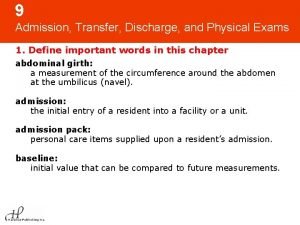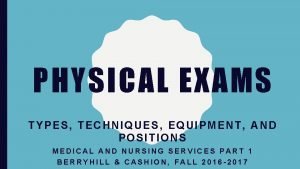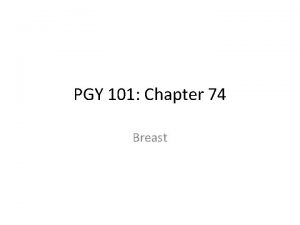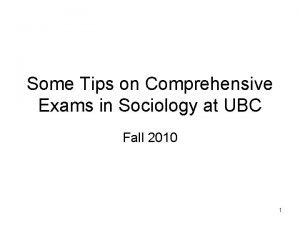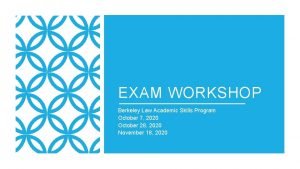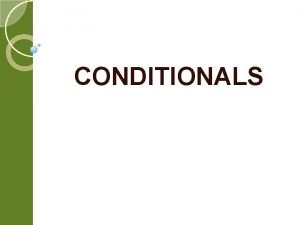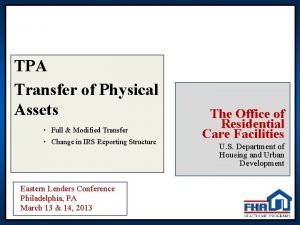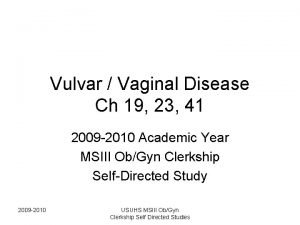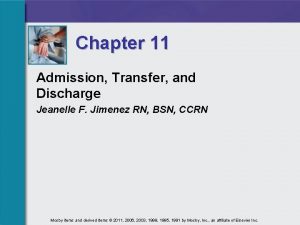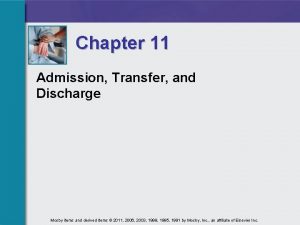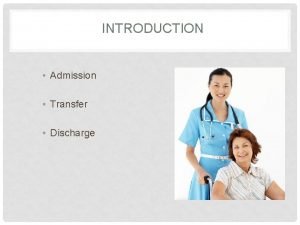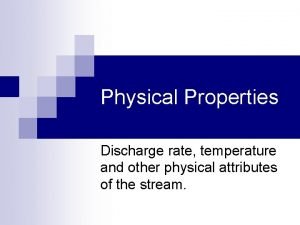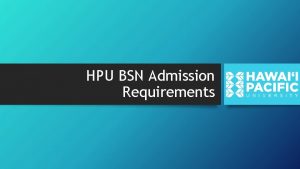9 Admission Transfer Discharge and Physical Exams 1




















































- Slides: 52

9 Admission, Transfer, Discharge, and Physical Exams 1. Define important words in this chapter abdominal girth: a measurement of the circumference around the abdomen at the umbilicus (navel). admission: the initial entry of a resident into a facility or a unit. admission pack: personal care items supplied upon a resident’s admission. baseline: initial value that can be compared to future measurements.

9 Admission, Transfer, Discharge, and Physical Exams 1. Define important words in this chapter (con’t) bedridden: confined to bed. contracture: the permanent and often painful shortening of a muscle, usually due to a lack of activity. discharge: a doctor’s order that releases a resident to leave a facility to go home or to another facility. dorsal recumbent: position with the person flat on her back with knees flexed and slightly separated; feet are flat on bed.

9 Admission, Transfer, Discharge, and Physical Exams 1. Define important words in this chapter (con’t) kilogram: 1000 grams; 1 kilogram = 2. 2 pounds. knee-chest: position with the person lying on his abdomen with knees pulled up towards the abdomen and with legs separated; arms are pulled up and flexed; the head is turned to one side. lithotomy: position with the person on her back with her hips at the edge of the exam table; legs are flexed and feet are in padded stirrups. metric: system of weights and measures based upon the meter.

9 Admission, Transfer, Discharge, and Physical Exams 1. Define important words in this chapter pound: measurement of weight equal to 16 ounces. transfer: an order that moves a resident from one unit to another within the same facility.

9 Admission, Transfer, Discharge, and Physical Exams 2. List factors for families in choosing a facility Some factors families consider before placing a loved on in a facility include: • Do the staff seem courteous and friendly? • Do most of the staff speak the resident’s native language? • Are there enough staff members on duty? • Is there a strong smell of urine or other foul odors in the facility? • Are the residents up and dressed early in the morning, etc?

9 Admission, Transfer, Discharge, and Physical Exams 3. Explain the nursing assistant’s role in the emotional adjustment of a new resident Guidelines for helping a new resident adjust include: • Having a positive attitude • Being tactful • Communicating clearly • Showing respect for the resident’s belongings • Being responsible • Being honest • Listening to the resident if she wants to talk, etc.

9 Admission, Transfer, Discharge, and Physical Exams 4. Describe the nursing assistant’s role in the admission process Guidelines for admission include: • Wash your hands and then gather items for the new resident’s room • Prepare the room before the resident arrives • Introduce yourself • Don’t rush the process for the resident • Introduce the resident to his roommate and others • Explain day-to-day life in the facility • Explain how to work the TV and phone, etc.

Admitting a resident Equipment: may include admission paperwork (checklist and inventory form), gloves, and vital signs equipment 1. Identify yourself by name. Identify the resident. Greet the resident by name. 2. Wash your hands. 3. Explain procedure to the resident. Speak clearly, slowly, and directly. Maintain face-to-face contact whenever possible. Encourage resident to assist if possible.

Admitting a resident 4. Provide for the resident’s privacy with a curtain, screen, or door. Ask the family to step outside until the initial admission process is complete. Show them where they may wait and let them know how long they will have to wait. Tell them where they can get refreshments.

Admitting a resident 5. If part of facility procedure, do these things: – Take the resident’s height, weight, and vital signs. (Height and weight procedures follow; vitals signs are in Chapter 13. ) Most facilities require baseline height, weight, and vital sign measurements. Baseline signs are initial values that can be compared to future measurements. Document on admission form and elsewhere per facility policy.

Admitting a resident – – – (con’t) Document on admission form and elsewhere per facility policy. Obtain a urine specimen if required (see Chapter 16). Complete the paperwork. Take an inventory of all of the personal items. Help the resident put personal items away. Label each item if it is facility policy. If the resident has valuables, ask the nurse for instructions.

Admitting a resident – (con’t) Fill the water pitcher with fresh water unless the nurse has instructed you not to. 6. When the initial portion of the admission is complete, locate the family and let them know they may return to the resident’s room.

Admitting a resident 7. Show the resident the room and bathroom. Explain how to work the bed controls and the call light. Point out the lights, telephone, and television and how to work them. Give the resident any information on menus, dining times, and activity schedules. 8. Introduce the resident to his roommate, if there is one. Introduce other residents and staff.

Admitting a resident 9. Make resident comfortable. Remove privacy measures. 10. Leave call light within resident’s reach. 11. Wash your hands. 12. Be courteous and respectful at all times. Let the resident know when you are leaving. Ask if he needs anything else. 13. Document procedure using facility guidelines.

Measuring and recording weight of an ambulatory resident Equipment: standing/upright scale, pen and paper to record your findings 1. Identify yourself by name. Identify the resident. Greet the resident by name. 2. Wash your hands. 3. Explain procedure to the resident. Speak clearly, slowly, and directly. Maintain face-to-face contact whenever possible. Encourage resident to assist if possible.

Measuring and recording weight of an ambulatory resident 4. Provide for the resident’s privacy with a curtain, screen, or door. 5. Start with the scale balanced at zero. If you do not know how to balance the scale, ask the nurse. 6. Help the resident remove shoes and step onto the center of the scale. The resident should be facing the scale. Once on the scale, his arms must hang free.

Measuring and recording weight of an ambulatory resident 7. Weigh the resident. This is done by balancing the scale by making the balance bar level. Move the small and large weight indicators until the bar balances. Read the two numbers shown (on the small and large weight indicators) when the bar is balanced. Add these two numbers together. This is the resident’s weight (Fig. 9 -7). 8. Help the resident off the scale before recording weight. Fig. 9 -7. Move the small and large weight indicators until the bar balances.

Measuring and recording weight of an ambulatory resident 9. Record the resident’s weight. 10. Remove privacy measures. 11. Leave call light within resident’s reach. 12. Wash your hands. 13. Be courteous and respectful at all times. 14. Report any changes in the resident to the nurse. Document procedure using facility guidelines.

Measuring and recording weight of a bedridden resident Equipment: scale, pen and paper to record your findings Have another co-worker assist. 1. Identify yourself by name. Identify the resident. Greet the resident by name. 2. Wash your hands.

Measuring and recording weight of a bedridden resident 3. Explain procedure to the resident. Speak clearly, slowly, and directly. Maintain face-to-face contact whenever possible. Encourage resident to assist if possible. 4. Provide for the resident’s privacy with a curtain, screen, or door. 5. Practice good body mechanics. Adjust the bed to a safe level, usually waist high. Lock the bed wheels.

Measuring and recording weight of a bedridden resident 6. Start with the scale balanced at zero. If you do not know how to balance the scale, ask the nurse. 7. Examine the sling, straps, chains, and/or pad for any damage. Do not use the scale if you find damage. 8. Turn linen down so that it is off the resident.

Measuring and recording weight of a bedridden resident 9. Turn resident to one side away from you (Chapter 11) or if flat pad scale is used, slide resident onto pad using a helper. If sling is used, remove from the scale and place underneath the resident without wrinkling. 10. With a sling, turn the resident back to the supine (back) position and straighten sling. 11. Attach the sling to the scale or if using a flat pad scale, position resident securely on the pad.

Measuring and recording weight of a bedridden resident 12. Check the straps or other connectors, and raise the sling or the pad until the resident is clear of the bed. With some scales, you can keep the resident directly over the bed while weighing him. With others, you have to move the scale away from the bed. Either way, secure the resident before moving the scale.

Measuring and recording weight of a bedridden resident 13. For digital scales, turn them on and note reading. With other scales, move the weights until you get a reading. Note the weight. 14. Lower the resident back down on the bed. If using a sling, turn resident to both sides to remove the sling. If using a pad scale, carefully slide the resident back onto the bed. 15. Record the resident’s weight.

Measuring and recording weight of a bedridden resident 16. Make resident comfortable. Replace bed linens. 17. Return bed to low position if raised. Ensure resident’s safety. Remove privacy measures. 18. Leave call light within resident’s reach. 19. Wash your hands. 20. Be courteous and respectful at all times.

Measuring and recording weight of a bedridden resident 21. Report any changes in the resident to the nurse. Document procedure using facility guidelines.

Measuring and recording height of an ambulatory resident Equipment: standing/upright scale, pen and paper to record your findings 1. Identify yourself by name. Identify the resident. Greet the resident by name. 2. Wash your hands. 3. Explain procedure to the resident. Speak clearly, slowly, and directly. Maintain face-to-face contact whenever possible. Encourage resident to assist if possible.

Measuring and recording height of an ambulatory resident 4. Provide for the resident’s privacy with a curtain, screen, or door. 5. Help the resident to step onto scale, facing away from the scale. 6. Ask the resident to stand straight. Help as needed. 7. Pull up measuring rod from back of scale. Gently lower measuring rod until it rests flat on the resident’s head (Fig. 9 -10). Fig. 9 -10. To determine height, gently lower measuring rod until it rests flat on resident’s head.

Measuring and recording height of an ambulatory resident 8. Determine resident’s height. 9. Help the resident off scale before recording height. Make sure measuring rod does not hit resident in the head while trying to help resident off the scale. 10. Record height. 11. Remove privacy measures. 12. Leave call light within resident’s reach.

Measuring and recording height of an ambulatory resident 13. Wash your hands. 14. Be courteous and respectful at all times. 15. Report any changes in the resident to the nurse. Document procedure using facility guidelines.

Measuring and recording height of a bedridden resident Equipment: measuring tape (Fig. 9 -11), pencil, pen and paper to record your findings 1. Identify yourself by name. Identify the resident. Greet the resident by name. 2. Wash your hands. 3. Explain procedure to the resident. Speak clearly, slowly, and directly. Maintain face-to-face contact whenever possible. Encourage resident to assist if possible. Fig. 9 -11. A tape measure.

Measuring and recording height of a bedridden resident 4. Provide for the resident’s privacy with a curtain, screen, or door. 5. Practice good body mechanics. Adjust the bed to a safe level, usually waist high. Lock the bed wheels. 6. Turn linen down so it is off the resident. 7. Position resident lying straight in the supine (back) position.

Measuring and recording height of a bedridden resident 8. Using a pencil, make a small mark on the bottom sheet at the top of the resident’s head. 9. Make another pencil mark at the bottom of the resident’s feet (Fig. 9 -12). 10. Using the tape measure, measure the area between the pencil marks. This is the resident’s height. 11. Record the resident’s height. Fig. 9 -12. Make marks on the sheet at the resident’s head and feet.

Measuring and recording height of a bedridden resident 12. Make resident comfortable. Replace bed linen. 13. Return bed to low position if raised. Ensure resident’s safety. Remove privacy measures. 14. Leave call light within resident’s reach. 15. Wash your hands. 16. Be courteous and respectful at all times.

Measuring and recording height of a bedridden resident 17. Report any changes in the resident to the nurse. Document procedure using facility guidelines

Measuring abdominal girth Equipment: measuring tape, pen and paper to record your findings 1. Identify yourself by name. Identify the resident. Greet the resident by name. 2. Wash your hands. 3. Explain procedure to the resident. Speak clearly, slowly, and directly. Maintain face-to-face contact whenever possible. Encourage resident to assist if possible.

Measuring abdominal girth 4. Provide for the resident’s privacy with a curtain, screen, or door. 5. Practice good body mechanics. Adjust the bed to a safe level, usually waist high. Lock the bed wheels. 6. Position resident lying straight in the supine (back) position.

Measuring abdominal girth 7. Turn linen down and raise gown or top enough to expose only the abdomen. Keep all areas covered that do not need to be exposed. Promote resident’s right to dignity and privacy. 8. Gently wrap measuring tape around the resident’s abdomen at the level of the navel. 9. Read the number where the ends of the tape meet (Fig. 9 -13). Fig. 9 -13. After wrapping the measuring tape around the resident’s abdomen, read the number where the ends of the tape meet.

Measuring abdominal girth 10. Carefully remove the tape measure. Record abdominal girth measurement. 11. Make resident comfortable. Replace clothing and bed linen. 12. Return bed to low position if raised. Ensure resident’s safety. Remove privacy measures. 13. Leave call light within resident’s reach.

Measuring abdominal girth 14. Wash your hands. 15. Be courteous and respectful at all times. 16. Report any changes in the resident to the nurse. Document procedure using facility guidelines.

9 Admission, Transfer, Discharge, and Physical Exams 5. Explain the nursing assistant’s role during an inhouse transfer of a resident Guidelines for in-house transfer include: • Notifying the resident as soon as possible • Packing up the resident’s belongings • Identifying the mode of transfer (i. e. , wheelchair, bed, stretcher) • Introducing the resident when you arrive at the new unit or room • Unpacking the resident’s belonging in the new unit or room • Helping the resident to get settled and comfortable, etc.

Transferring a resident Equipment: may include a wheelchair or stretcher, cart for belongings, all of the resident’s personal care items 1. Identify yourself by name. Identify the resident. Greet the resident by name. 2. Wash your hands. 3. Explain procedure to the resident. Speak clearly, slowly, and directly. Maintain face-to-face contact whenever possible. Encourage resident to assist if possible.

Transferring a resident 4. Provide for the resident’s privacy with a curtain, screen, or door. 5. Collect the items to be moved onto the cart, and ask another staff member to help take them to the new location. 6. Lock wheelchair or stretcher wheels. Help the resident into the wheelchair or onto the stretcher. Take him or her to the new area.

Transferring a resident 7. Introduce the resident to the new residents and staff. 8. Lock wheelchair or stretcher wheels. Transfer the resident to the new bed, if needed. 9. Unpack all belongings. Help the resident to put personal items away. 10. Make resident comfortable. Remove privacy measures.

Transferring a resident 11. Leave call light within resident’s reach. 12. Wash your hands. 13. Be courteous and respectful at all times. 14. Report any changes in the resident to the nurse. Document procedure using facility guidelines.

9 Admission, Transfer, Discharge, and Physical Exams 5. Explain the nursing assistant’s role during the discharge of a resident Guidelines for the discharge of a resident include: • Collecting and packing the resident’s belongings • Being positive and reassuring about the discharge • Identify the need for a wheelchair or stretcher • Transfer him and his belongings to the car, etc.

Discharging a resident Equipment: may include a wheelchair or stretcher, cart for belongings, the discharge paperwork, including the inventory list done on admission, all of the resident’s personal care items 1. Identify yourself by name. Identify the resident. Greet the resident by name. 2. Wash your hands.

Discharging a resident 3. Explain procedure to the resident. Speak clearly, slowly, and directly. Maintain face-to-face contact whenever possible. Encourage resident to assist if possible. 4. Provide for the resident’s privacy with a curtain, screen, or door. 5. Compare the inventory list to the items being packed. Ask the resident to sign if all items are there.

Discharging a resident 6. Carefully put the items to be taken onto the cart, and ask another staff member to help transport items to the pick-up area. 7. Help the resident dress in clothing of his choice. Make sure the nurse has removed all dressings, IVs and tubes that need to be removed prior to discharge. 8. Lock wheelchair or stretcher wheels. Help him safely into the wheelchair or onto the stretcher (Chapter 11).

Discharging a resident 9. Help the resident to say his goodbyes to other residents and the staff. 10. Take him to the pick-up area. Lock wheelchair or stretcher wheels. Help the resident into the vehicle. Transfer personal items into the vehicle. 11. Say goodbye to the resident. You are responsible for the resident until he or she is safely in the car and the door is closed.

Discharging a resident 12. Wash your hands. 13. Document procedure using facility guidelines.

9 Admission, Transfer, Discharge, and Physical Exams Transparency 9 -1: Body Positions for Exams
 Chapter 9 admission transfer discharge and physical exams
Chapter 9 admission transfer discharge and physical exams Chapter 9 admission transfer discharge and physical exams
Chapter 9 admission transfer discharge and physical exams Chapter 11 admission transfer and discharge
Chapter 11 admission transfer and discharge Admission transfer and discharge
Admission transfer and discharge Admission of the patient
Admission of the patient Physical examination equipment
Physical examination equipment Requirements
Requirements What is a disturbance that transfers energy
What is a disturbance that transfers energy Sub cooling chart
Sub cooling chart Means of egress definition
Means of egress definition Exit exit access and exit discharge
Exit exit access and exit discharge What is rad short for
What is rad short for Poem on exams
Poem on exams Finland exams
Finland exams Adit registration
Adit registration Comprehensive exams
Comprehensive exams Prayer to st. joseph of cupertino
Prayer to st. joseph of cupertino Prayer for tests
Prayer for tests New york state teacher certification exams
New york state teacher certification exams Example exam
Example exam Berkeley law exams
Berkeley law exams English official exams
English official exams A psychologist who classifies an individual's personality
A psychologist who classifies an individual's personality Conditionals finish the sentences
Conditionals finish the sentences Monash e exam platform
Monash e exam platform 7 components of strategic staffing
7 components of strategic staffing Phys 172
Phys 172 Biometric assisted proctoring
Biometric assisted proctoring Cambridge exam invigilator
Cambridge exam invigilator Human resource planning question paper
Human resource planning question paper Febadvisor
Febadvisor Exams brunel
Exams brunel Exams actesting
Exams actesting Are the keystone exams mandatory
Are the keystone exams mandatory Vce physics resources
Vce physics resources Rcpch exams
Rcpch exams Compassionate consideration
Compassionate consideration Indiana teacher certification practice test
Indiana teacher certification practice test Derived grade exams
Derived grade exams Math placement test yale
Math placement test yale Decas exams
Decas exams Paragraph about exams
Paragraph about exams Myp exams
Myp exams Ib history ib exam questions
Ib history ib exam questions Jummah salah rakats
Jummah salah rakats Washback definition
Washback definition Www.awinfosys.com/eassessment/exams sample.htm
Www.awinfosys.com/eassessment/exams sample.htm Aspec exams
Aspec exams Modified tpa
Modified tpa Putting service pricing into practice
Putting service pricing into practice Physical fitness grade 9
Physical fitness grade 9 Wound discharge colors
Wound discharge colors Yellow cottage cheese discharge
Yellow cottage cheese discharge

